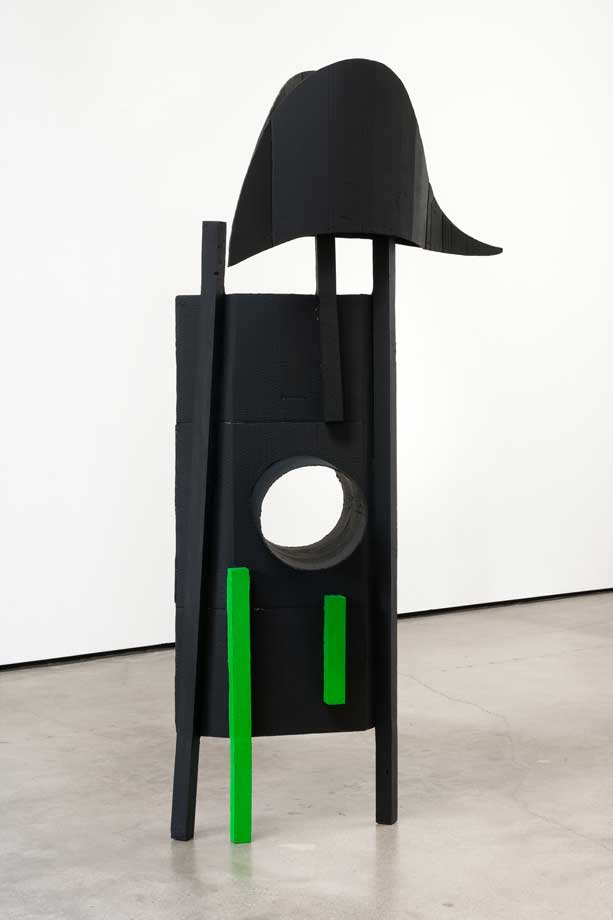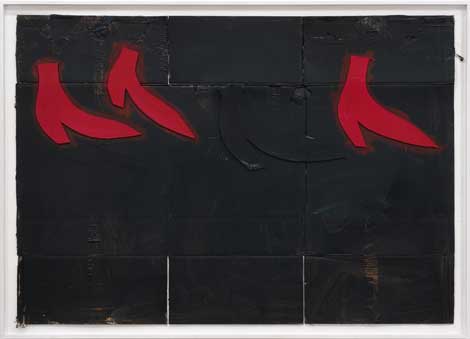Your cart is currently empty!
Florian Morlat

There are two clues Florian Morlat is up to something different with his show(s) at Cherry and Martin, which held court there for two months. With overlap between the shows, and some work reappearing in slightly different configurations, the second made clear a dry, situational theatricality between the progression of collages and sculptural pieces from one gallery to the next. This was subtly achieved in the last gallery, where the installation conveyed an impression of large puppets and scenic props set in a quasi-confrontational array—a tension that, in comic reversal, made the viewer the object of the farce.
Morlat works in a constructivist-Pop style owing something to Arp and Miro, Franz West, agit-prop graphics, and possibly Jay Ward, whose out-sourced animation studio, Gamma Productions, might be the real influence here. For the most part, with relatively humble materials—principally cardboard, wood, oil and acrylic paint in a palette that progresses from deliberately subdued earth tones and matte blacks to neon primaries and secondaries—Morlat gives us a kind of pilgrim’s progress, as such might have been rendered by Ward/Gamma in one of their famous “Fractured Fairy Tales.”

Untitled (Cardboard Collage)
2013, Courtesy Cherry and Martin, Los Angeles, Photo by Robert Wedemeyer
Morlat’s schematic, almost abstracted, figurative elements have the quality of symbols, in panels mostly of flattened cardboard boxes and constructions of wood sticks or staffs and modeled cardboard or fabric. On one flattened black box— Untitled (all works 2013)—four cut-out “court shoes” or possibly “Beatle boots,” three red, and one black (is the black one Paul?) stumble across the top. A blackened plank of cardboard with unevenly cut-out rectangles supports a molded parabolic volume of black, edged and shot through with yellow that might be a moustache (a repeated motif), but is more probably a floppy bicorne hat, variations of which also repeat through the show. The irregular rectangular slots are edged with yellow and fuschia bleeds—a kinescopic cravat.
Morlat’s parenthetical title of this work is Where the action is, which renders Pop into a kind of pop music-pathetic, referencing—not unlike the Beatle boots—the world of Anglo-American mid-1960s pop music. Another untitled construction with the same parenthetical title features the same, slightly flattened bicorne (Napoleonic?) isolated on a pole or dowel, a short peg protruding from it, as if to hang a hat—a joke that might fall flat unaccompanied. But other collages and constructions convey the sense of an encrypted code. In the most minimal renditions, the linguistic (and rhythmic) aspect appears suppressed. In a few constructions, the obscurantist impulse is explicit—forms (as simple as a T-square) deliberately confused or obscured with plaster or straw. There are “ghosts” in these crude machines of meaning.
The last gallery’s array of constructions did not necessarily clarify the semiotic snowstorm that had advanced the viewer to it. But the various screens and boxes—peppered with perforations and matchstick-like bits of wood, in neon green, fuschia and rust thrust, parried and fairly danced with the viewer in shifting attitudes and staccato rhythm. The semiotic wilderness of signs, symbols, ciphers and language—that in contemporary life frequently seems a broken code—is not necessarily new material in visual art, but Morlat seems to know how to dance the mess around.